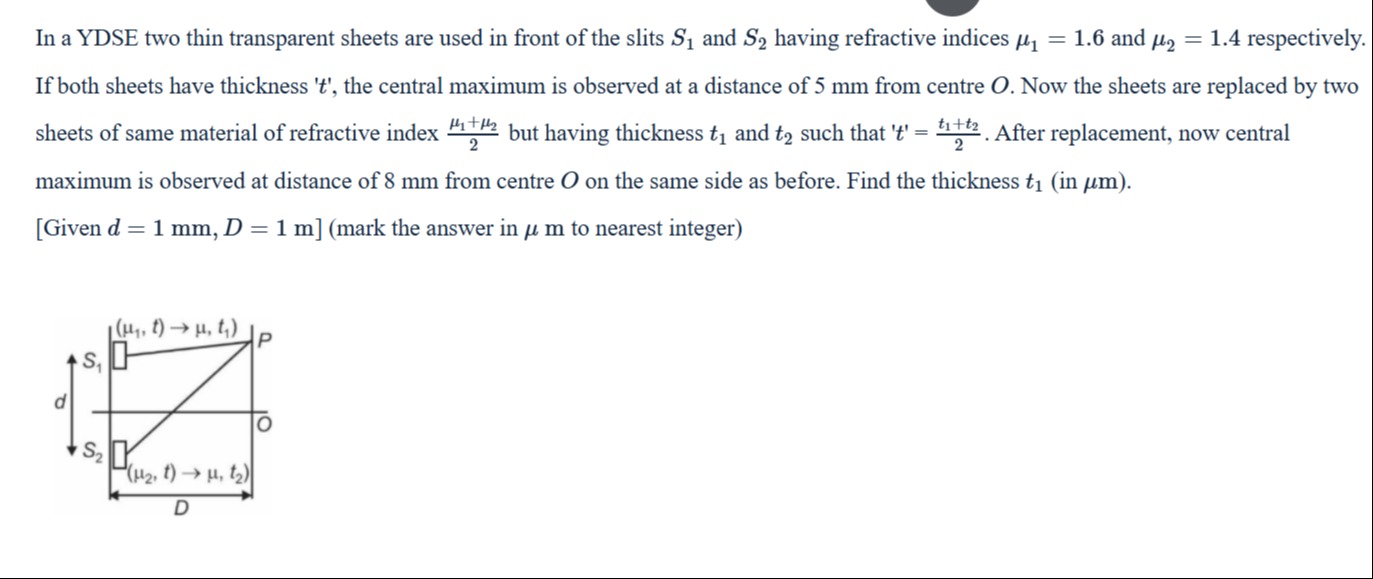Question
Question: In a YDSE two thin transparent sheets are used in front of the slits $S_1$ and $S_2$ having refracti...
In a YDSE two thin transparent sheets are used in front of the slits S1 and S2 having refractive indices μ1=1.6 and μ2=1.4 respectively.
If both sheets have thickness 't', the central maximum is observed at a distance of 5 mm from centre O. Now the sheets are replaced by two sheets of same material of refractive index 2μ1+μ2 but having thickness t1 and t2 such that t′=2t1+t2. After replacement, now central maximum is observed at distance of 8 mm from centre O on the same side as before. Find the thickness t1 (in μm).
[Given d = 1 mm, D = 1 m] (mark the answer in μm to nearest integer)

33
Solution
The shift in the central maximum in a YDSE due to the insertion of thin transparent sheets of thicknesses t1 and t2 and refractive indices μ1 and μ2 in front of slits S1 and S2 respectively is given by
yc=dD[(μ1−1)t1−(μ2−1)t2].
Here, yc is the distance of the central maximum from the original center O. We assume the positive direction of y is upwards. If S1 is the upper slit and S2 is the lower slit, a positive yc means the central maximum shifts upwards.
In the first scenario, sheets of thickness t and refractive indices μ1=1.6 and μ2=1.4 are placed in front of S1 and S2 respectively. The central maximum is observed at yc=5 mm from O.
5×10−3 m=1×10−3 m1 m[(1.6−1)t−(1.4−1)t]
5×10−3=103[0.6t−0.4t]
5×10−3=103(0.2t)
5×10−3=200t
t=2005×10−3=2×1025×10−3=2.5×10−5 m=25×10−6 m=25μm.
In the second scenario, the sheets are replaced by two sheets of the same material with refractive index μ=2μ1+μ2=21.6+1.4=1.5. The thicknesses are t1 and t2 in front of S1 and S2 respectively. The central maximum is observed at yc′=8 mm from O on the same side as before, so yc′=8 mm.
We are given that t′=2t1+t2=t. So, t1+t2=2t=2×25μm=50μm.
The shift of the central maximum is:
yc′=dD[(μ−1)t1−(μ−1)t2]=dD(μ−1)(t1−t2)
8×10−3 m=1×10−3 m1 m(1.5−1)(t1−t2)
8×10−3=103(0.5)(t1−t2)
8×10−3=500(t1−t2)
t1−t2=5008×10−3=5×1028×10−3=1.6×10−5 m=16×10−6 m=16μm.
We have a system of two linear equations for t1 and t2:
-
t1+t2=50μm
-
t1−t2=16μm
Adding the two equations:
(t1+t2)+(t1−t2)=50+16
2t1=66
t1=266=33μm.
Substituting t1=33 into the first equation:
33+t2=50
t2=50−33=17μm.
The thickness t1 is 33μm. We need to mark the answer in μm to the nearest integer. Since 33 is an integer, the answer is 33.
